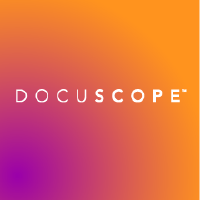DocuScope
Corpus Analysis & Concordancer
© David West Brown, David Kaufer, Suguru Ishizaki
Getting Started
DocuScope Corpus Analysis & Concordancer (DocuScope CA) is a powerful web-based tool that combines traditional corpus analysis with cutting-edge natural language processing to make sophisticated textual analysis accessible to students, researchers, and educators.
What is DocuScope CA?
DocuScope CA is a Streamlit-powered application that integrates three key technologies:
- spaCy NLP processing with custom-trained models for both part-of-speech and rhetorical tagging
- DocuScope rhetorical analysis framework for understanding how language functions in context
- OpenAI integration for AI-assisted analysis and visualization
The tool enables users to analyze small to medium-sized corpora (collections of texts) to understand patterns in language use, discover rhetorical strategies, and explore linguistic variation across different types of writing.
How DocuScope CA Compares to Other Tools
Similar to Traditional Concordancers
Like popular tools such as AntConc, DocuScope CA provides:
- Word frequency analysis and statistical summaries
- KWIC (Keywords in Context) displays for examining word usage patterns
- N-gram analysis to identify common phrases and collocations
- Corpus comparison capabilities for contrasting different text collections
- Downloadable results for further analysis or reporting
What Makes DocuScope CA Different
DocuScope CA goes beyond traditional concordancing by offering:
Integrated Rhetorical Analysis
- DocuScope tagging that identifies rhetorical functions (confidence, stance, organization, etc.)
- Dual annotation system providing both grammatical (POS) and rhetorical tags simultaneously
- Functional language analysis that reveals how language works rather than just what words appear
AI-Powered Assistance
- Assisted plotting with OpenAI helping generate and refine visualizations
- Intelligent analysis suggestions based on corpus patterns
- Natural language queries for exploring data
Educational Focus
- Pre-loaded corpora including MICUSP, BAWE, Elsevier, and HAP-E datasets
- Guided workflows designed for classroom and research use
- Multiple analysis levels from basic frequency counts to advanced rhetorical patterns
Modern Web Interface
- No software installation required - runs entirely in your web browser
- Interactive visualizations with Plotly integration
- Session management that preserves your work across analysis sessions
- Real-time processing with immediate results
Key Analysis Capabilities
DocuScope CA offers 14 main analysis modules organized into intuitive workflows:
Core Analysis Tools
- Token Frequencies - Word and phrase frequency analysis with filtering options
- Tag Frequencies - Analysis of grammatical and rhetorical tag distributions
- N-grams - Identification of common word sequences and phrases
- Collocations - Statistical analysis of word associations and co-occurrences
- KWIC (Keywords in Context) - Detailed examination of word usage in context
Comparative Analysis
- Compare Corpora - Statistical comparison between different text collections
- Compare Corpus Parts - Analysis of variation within a single corpus
Advanced Features
- Advanced Plotting - Create custom visualizations and statistical graphics
- Single Document Analysis - Deep dive into individual texts
- Assisted Plotting - AI-powered visualization generation and refinement
- Assisted Analysis - OpenAI-guided exploration of corpus patterns
Data Management
- Download Corpus - Export processed data for external analysis
- Download Tagged Files - Save annotated texts with linguistic tags
- Manage Corpus Data - Upload, process, and organize your text collections
Getting Started: Your First Steps
Step 1: Access the “Manage Corpus Data” Interface
The “Manage Corpus Data” page is your starting point for any analysis. This interface allows you to work with texts in several ways:
Option A: Use Pre-loaded Corpora
Start with ready-to-analyze datasets: - MICUSP - High-quality student writing from University of Michigan - BAWE - British academic writing across disciplines and levels - Elsevier - Published academic articles across 20 scientific fields - HAP-E - Human vs. AI writing comparisons
Option B: Upload External Data
Bring your own pre-processed corpus: - Upload .parquet files from other corpus analysis tools - Load previously processed DocuScope CA datasets - Import data with existing annotations
Option C: Process New Texts
Upload and analyze your own collection: - Upload multiple .txt files (essays, articles, documents) - Choose between full DocuScope model or Common Dictionary tagging - Let the system process and tag your texts automatically
Step 2: Explore Your Data
Once your corpus is loaded:
- Start with Token Frequencies to get familiar with your data’s vocabulary
- Examine Tag Frequencies to understand rhetorical and grammatical patterns
- Use KWIC analysis to see how key terms function in context
- Try corpus comparisons if you have multiple datasets
Step 3: Dive Deeper
As you become comfortable with the basics:
- Experiment with N-grams to find common phrases and expressions
- Explore collocations to understand word associations
- Use advanced plotting to create publication-ready visualizations
- Try AI-assisted features for guided analysis and insights
Who Can Use DocuScope CA?
Students
- Analyze your own writing for rhetorical effectiveness
- Compare your work to published examples in your field
- Understand disciplinary writing conventions
- Develop critical language awareness
Researchers
- Conduct corpus-based studies of language variation
- Analyze rhetorical strategies across genres and contexts
- Compare human and AI-generated texts
- Investigate cross-cultural writing patterns
Educators
- Demonstrate linguistic concepts with real data
- Create assignments using provided corpora
- Help students understand academic writing conventions
- Integrate corpus analysis into writing instruction
Ready to Begin?
The best way to learn DocuScope CA is to start exploring. We recommend:
- Begin with a pre-loaded corpus to familiarize yourself with the interface
- Follow the guided workflows in our documentation
- Start simple with basic frequency analysis before moving to advanced features
- Experiment freely - the tool is designed for exploration and discovery
New to corpus analysis? Start with our Load Corpus guide to learn the fundamentals, then explore the Token Frequencies tutorial to see the tool in action.
Ready to dive in? Visit the “Manage Corpus Data” page in DocuScope CA to load your first corpus and begin exploring the fascinating world of computational text analysis.
